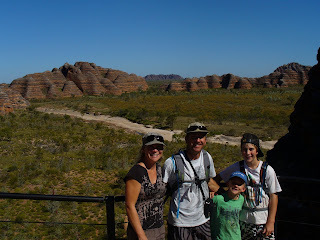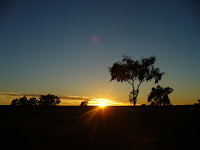3rd May
The drive from Yulara to Kings Canyon is a sealed road back along Lasseter Highway and turning off onto Luritja Road. We stopped off along the way and walked out to Kathleen Springs - only a short walk but providing plenty of information about the way in which Aborigines and Stockmen used the area. Kathleen Springs is a permanent waterhole with cliffs on three sides which stockmen used to trap their cattle after having let them roam free. The cattle had to go there to get water and the stockmen had set up a one way gate so they could get in but not out again. On the way back to the car we saw some processionary caterpillars - a strange variety which has hairs that are irritating to your skin. They walk in single file with each caterpillar holding on to one in front. If the connection breaks they all stop until they are all joined up again!
 |
| Processionary Caterpillars |
From Kathleen Springs to Kings Canyon was only a short drive and we decided to fill up with fuel once there to avoid having to fill up in the morning. We now had a new leader for the most expensive fuel in Australia with 220 cents per litre (OMG). Setting up camp we bent a lot of heavy duty pegs on the rock hard ground but were organised in time to go and see the sun setting on the entrance to Kings Canyon from the sunset viewing area at the resort - beautiful colours changing as the sun went down.
Once again, as with wherever we go, we were inundated with mice that come out at night. It seems the whole of central Australia is in the midst of a mouse plague with all the extra food they have as a result of the plentiful rains. On this occasion the nocturnal birds of prey came from the trees and plucked the mice from the top of our camper trailer as we tried to sleep. Good on you fellas - now we can get some sleep!
4 May
Today we decided to start reasonably early and hike around the rim of the canyon - a fairly energetic 7km walk which took in some spectacular scenery. The first section was the most challenging with lots of stairs as we ascended to the top of the canyon. Once there the views were amazing. At every vantage point there was another awesome view and we were snapping photo after photo as we turned each corner.
 |
| Kings Canyon |
 |
| Kings Canyon - The Garden of Eden |
From the strange rock formations that make up The Lost City to the Gardens of Eden and the sheer walls of the canyon with their multi coloured sandstone.
We only saw a small number of animals as we happened to be walking at the same pace as some very noisy tourists who the animals could hear for a long time before they arrived. We did see a beautiful little gecko that can change his colour to match his surrounds - very clever and would not have seen him had he not moved when he did.
This is a truly amazing walk and probably my (Tim's) highlight so far. The effort taken in constructing the track is quite amazing with steps cemented in, bridges built and boardwalks constructed to make the walk possible.
 |
| Overlooking The Lost City - Kings Canyon |
We had lunch and persuaded the now tired boys that a short walk up the Creek Walk that runs through the centre of Kings Canyon. While not a difficult walk it is very pretty as it meanders up the now dry creek bed shaded by River Red Gums and between massive boulders that have at some time crumbled from the canyon walls.
On returning to our campsite Declan and Thomas decided to go for a swim in the Resort's unheated pool and turned blue in the process. It was a very quick swim.
While we were cooking dinner Declan found his friend Declan again and we decided we would go to the Thirsty Dingo Bar with his family after dinner. Their was a comedy band playing there and they had the kids on stage playing instruments and adults up performing as well.



















































